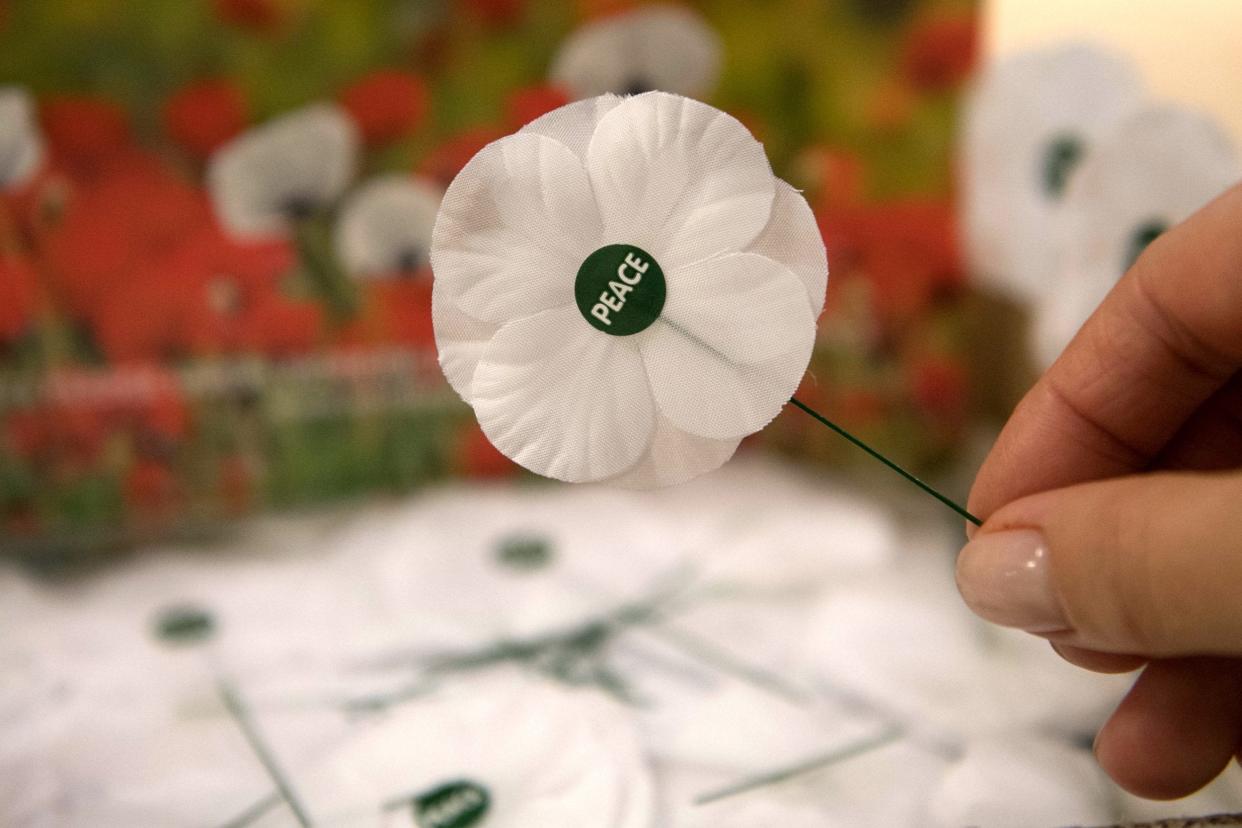Poppy Appeal Remembrance Day 2018: Red, purple and white poppy meanings and when to stop wearing a poppy

Thanks to the Poppy Appeal, thousands of us wore our poppies with pride yesterday to mark Remembrance Day.
Whilst many will stick to the traditional red colour, you may notice others sporting white and even purple poppies.
The wearing of white poppies sparks a row year after year. Conservative MP Johnny Mercer has referred to them as "attention seeking rubbish."
So why are there different coloured poppies and what's all the controversy about? Here's everything you need to know:
Why do we have red poppies?

The Poppy Appeal was first launched in 1921 to help remember those who fought in the war.
The poppy was chosen because they grow in the fields of northern France and Belgium - where some of World War I's bloodiest battles took place.
The Royal British Legion, which started the Poppy Appeal, give the money raised to the service men and women who are still alive and whose lives have been changed by war.
Poppies are distributed across the UK, including at supermarkets, train stations, shops, high streets and online at poppyshop.org.uk.
However, some people choose not to wear them because they believe it has become a political tool to justify war.
News presenter Jon Snow famously refused to wear a poppy on air, citing an "unpleasant breed of poppy fascism."
He added: "I respect our armed forces, the sacrifice and the loss, and like others, I remember them on Remembrance Sunday. That's the way it is. I won't be wearing a black tie for anyone's death - I don't for my own relatives, so why on earth would I for anyone else's?"
This year, the red poppies will feature a golden "1918-2018" print on the leaf to commemorate 100 years since the Armistice was signed on November 11.
What do white poppies mean?
According to the Peace Pledge Union (PPU) which distributes them, white poppies symbolise remembrance for all victims of war, commitment to peace and a challenge to the glamorisation of conflict.
They were first introduced by the Women's Co-operative Guild in 1933 to symbolise a message of "no more war" after WWI.
The white poppies are intended to remember "all those killed in war" seeking to bring an end to "the exclusion of civilians from mainstream Remembrance events."

According to the PPU, around 10,000 white poppies have been sold every year since 2014.
White poppies are also worn in New Zealand for Anzac Day and Remembrance Day.
Why are white poppies controversial?
White poppies are attention seeking rubbish. Ignore the wearers of them. If you don’t want to wear a poppy don’t bother; they fought and died so you could choose. But don’t deliberately try and hijack it’s symbolism for your own ends. Well done @BrianWoodMC https://t.co/HRK3wW3qY5
— Johnny Mercer MP (@JohnnyMercerUK)
Some critics say that white poppies disrupt the underlying message of red poppies and by association, Armistice Day.
Last year, Afghan veteran Colonel Richard Kemp claimed that they are a "left-wing political symbol" and an "insult to the war dead."
Sharing a similar sentiment, Mr Mercer said people should "ignore" those who wear white poppies.
In a tweet, he wrote: "If you don't want to wear a poppy don't bother, they fought and died so you could choose. But don't deliberately try and hijack its symbolism for your own ends."
The Royal British Legion says it "defends the right to wear different poppies" but that it will not sell red poppies alongside other colours to avoid confusion.
It said that the red poppy "is a symbol of peace inclusive of all regardless of race, belief, origin, or sexual/gender identity.
"Remembrance is neutral on both causes and consequences of individual conflicts and is above partisan and political interpretation."
White poppies can be purchased through Peace Pledge Union.
What's the meaning of purple poppies?
The less common purple poppies remember the animals killed in war.
It's estimated that eight million horses and donkeys died in WWI.
Founder Andy Smith said: "As an animal charity we strongly believe that animals lost whilst serving should be remembered.
"We want to acknowledge the sacrifices that they have made, and continue to make, and ensure they are not forgotten."
The purple poppy was replaced with a purple paw badge in 2015.
Animal Aid Director Andrew Tyler said of the decision: “Our aim was to make it clear that animals used in warfare are indeed victims, not heroes.
"They do not give their lives; their lives are taken from them. But too often the narrative promoted by the media has been one of animals as the valiant servants of people in violent conflict. This is precisely the opposite message to that which we intended.”
Purple paw badges can be purchased through animalaid.org.
When to stop wearing a poppy
There are a lot of conflicting views on how long to wear your poppy for.
Many people choose to stop wearing a Poppy after Armistice Day on November 11, as it is often laid at the base of the cenotaph after the Remembrance Day Ceremony.
According to the Royal British Legion, you can wear a poppy anytime during the year as a sign of respect to those who lost their lives in war.
In conclusion: wear your poppy however and whenever you like, so long as it's worn with pride.
Read more
Rare poppies embossed with gold writing mark centenary of Armistice

 Yahoo News
Yahoo News 
